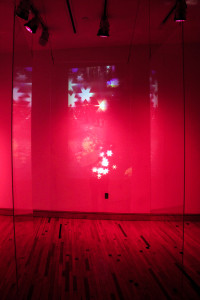
Behind the velvet curtains that cover its windows, the Smith Gallery is bathed in a seductive rouge glow for “Seeing Red,” a minimalistic installation by studio art major Elli Jung ’16. Three long, rectangular panes of glass hang from the ceiling at right angles to each other, forming a sort of open box. A projector plays a loop of a nighttime street scene—a bustling commercial district, apparently seen from across a small body of water, where swans are at play. Apart from the title and Jung’s name on the wall, there is no text to describe the piece.
Jung, however, is happy to open up about the background of her installation. The piece is a follow-up to the research project she conducted during her off-campus study program in Amsterdam last semester in which she investigated the past, present and future of the city’s famous Red Light District.
Prostitution was legalized in the Netherlands in 2000, but this has by no means resolved the many issues associated with prostitution.
“I did a lot of writing, a lot of journaling and [made] observations, meeting with sex workers, talking with women who were previously sex workers, looking at the lives of sex workers in a place where sex work is decriminalized,” Jung said. “They’re still stigmatized.”
The Dutch government has also been gradually trimming the number of the Red Light District’s “windows”—small storefront cabins where sex workers stand to attract clients, and can negotiate by opening the window, in actuality a door that opens only from the inside. Jung said that by 2020, there will only be 50 such windows in the Red Light District, out of the 500 allowed by the government in 2000.
“That’s a concern because the women are going to be out of jobs,” Jung said. “And when they apply for a job … they face stigma from their prior work.”
Jung says that sex trafficking still remains a problem in Amsterdam, though it has been eliminated in the Red Light District.
“What I’ve discovered is that [with legalization,] there’s more to promote healthier practices, safer practices, having police support and government support, to the industry to make sure [sex workers] are protected. I think that’s very important,” Jung said.
With her sparing use of materials, Jung attempted to recreate the Red Light District’s sensuous atmosphere, which she analogizes to an “erotic amusement park.”
“You can go anywhere, there’s beautiful people, the streets are crowded, there’s lots of noise. Sort of like a Disneyland of sex,” Jung said.
For her research, Jung took part in a workshop offered by the Prostitution Information Center, which allows participants to spend an evening in one of the District’s windows, in full view of passersbys. Jung took part in this, for four hours late on a Saturday evening.
“It was very intimidating approaching the glass … there were 80 to 100 people gathered when I went up to the window,” Jung said. “The advice I was given was look out over all of their heads, look at the brick buildings beyond you, look at the architecture, look at the lights, don’t look at their faces. And then as I became more comfortable, people were looking, people were knocking on the glass, people were trying to open the door to make offers.”
The minute-long video clip that plays in the “Seeing Red” exhibit was taken from Jung’s window during the evening, and addresses the issues of gaze and perspective. The camera looks at the sidewalk across the canal, where passersby can be seen milling around, some looking across to the camera.
“At the end of the workshop, I felt really empowered,” Jung said. “I realized that you can acknowledge or dis-acknowledge any person’s gaze. The way you pay attention to an individual can attract a client … And I think that works in spheres outside of this, in ways you can acknowledge people, or the amount of attention you want to pay into a certain relationship or friendship.”
Jung intends the interactive space to encourage empathy with sex workers, and to invite visitors to consider the dynamics of the situation.
“I want people to see that these sex workers are people too. They read Harry Potter, they go on Facebook, they watch Netflix, they are people with a profession,” Jung said. “There is a very strong control prostitutes have. They’re not just signs behind a window, it’s their gaze. And that’s a very powerful influence, the gaze.”
Jung understands the potential for confusion about her exhibit, given the lack of explicit explanation, but the choice was entirely intentional.
“I’m a bit of a minimalist,” Jung said. “Art isn’t always accessible, but you can experience something about art without understanding the meaning of it, and that can often stick with you longer than if you just look at something on a wall in a light space.”
For anyone interested for a fuller contextualization of her work, Jung will be publicly discussing her work in her closing reception, March 13 at 4:15 p.m. in the Smith Gallery.



















































